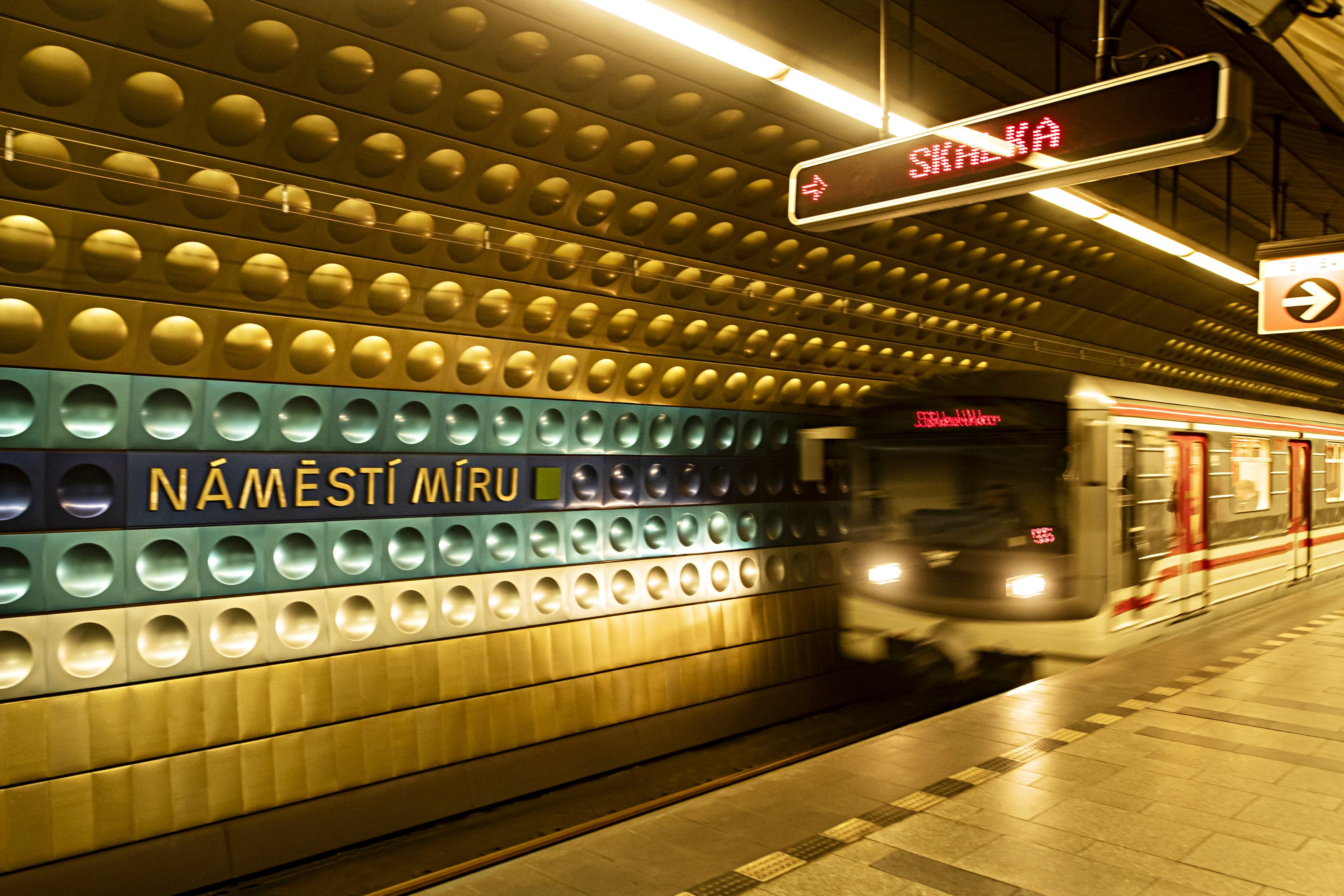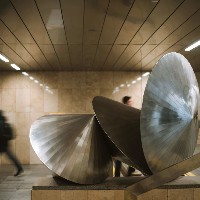Breadcrumbs navigation
Underground art
Did you know that Prague has one of the largest underground galleries of contemporary art and design? And even better, the entrance fee is only a few crowns. Surprisingly, this time we’re not heading to a museum, but rather to the stations and vestibules of the Prague metro system.
The idea to build an underground railway in Prague originated in 1898 in connection with extensive remediation work that was being carried out in the Old Town. However, concrete steps to implement this idea were not taken until the 1960s, when traffic in Prague was in danger of complete collapse. In 1974, the first section of line C, from Florenc to Kačerov, opened, followed four years later by first section of the line A between the Dejvická and Náměstí Míru stations. The newest line is line B, the first section of which was completed in 1985.
If we were look for ways to differentiate the individual metro lines, line C would be the oldest, line B the longest, and line A could arguably be considered the most beautiful. At the time it was built, the Prague metro was to become the showcase of the socialist states and proudly stand alongside the Moscow or Kiev metro systems. In comparison with them, however, its interiors were far more modern and represented the best that was created in Prague at the time.
The architects, designers, and artists who took part in creating visual aspects of the metro system were among the elite of our cultural scene. Today, even the richest cities would not be able to use the materials used to such an extent. The degree of timelessness and exclusivity of the metro architecture is perhaps also proved by the fact that it has become a backdrop for sci-fi films. And today is the time to slowly rediscover it.
Line A
The iconic “Áčko”, with its anodized aluminum cladding in the shape of convex and concave lenses (affectionally called prsa -” breasts” - and antiprsa in the jargon of metro aficionados) is one of the most beautiful and most photographed metro lines in Europe. The aluminum cladding not only has an aesthetic function, but also a practical one - it has the task of dampening the sound waves emitted by the heavy undercarriages of the trains.

The interiors of the stations are very simple, but all the more visually powerful example of the timeless work of the Prague metro architect Jaroslav Otruba. On one side of the station we see the vaults of the Gothic cellars under the Old Town, on the other side, a pop/op-art gesture, very catchy and "sexy". Today, the cladding itself has become a "must have" for every hipster, and many of them are willing to get a copy of it as a decoration for their living room.
The section of the line with the characteristic “lenses” starts at the Hradčanská station and continues below the Old Town and Vinohrady to the Flora station, where we can still find the original integrated lighting in the platform spaces. The apparent darkness of the tunnel spaces thus underlines the original concept of the mysterious character of the historical underground.
Each station has its own unique color, based on history and traditions and characterizes it in some way. For example, the gold at Můstek station refers to a place called the Golden Cross (Zlatý kříž), which is located nearby, and the red at Staroměstská is a reminder of a number of important historical events, from the Prague defenestration, to the execution of 27 Czech lords, to Victorious February. The Malostranská station, located next to the Baroque Wallenstein Garden (hence its green cladding) and the Wallenstein Riding School of the National Gallery, is also worthy of mention. There are copies of a number of Bernard Braun’s sculptures in the garden and in the metro station vestibules. Combined with the marble cladding, the space at some moments strongly resembles the Barcelona Pavilion of Mies van der Rohe.
Of the other stations on the line, the Želivského station is also worthy of mention - it is unique in that it has retained its original form since its opening in 1980. Here you can also see the original system of indirect lighting of the escalator tunnels, and the vestibule is decorated with a large stone mosaic depicting the Hussite preacher Jan Želivský.
Line B
The B line, or “Béčko”, is visually a bit more diverse. The stations on this line are both bored (orthogonal) and excavated (arched). The basic materials are glass and ceramic. Typical elements in the stations are large-format glass tiling on the platforms, ceramic tiling, white enamelled plates, indirectly lit escalator tunnels, and massive yellow light tubes. Exceptional glass tiles, lamps and sculptures from world-renowned artists were also created for some stations, but unfortunately in some cases, they have disappeared.
One of the most interesting stations on this line is the Anděl (Angel) station (originally Moskevská - Moscow), which was designed by architects from the former USSR, while Czech engineers in turn designed one of the Moscow stations, Pražská (Prague). Bronze castings with socialist motifs of cosmonauts and national friendship still hang on the white marble paneling.
Very exclusive decorations adorn the Karlovo náměstí (Charles Square) station, whose walls are covered with glass blocks designed by the world-famous glassmaker František Vízner. In the vestibule in the direction of Palackého náměstí, there is artistic stained glass behind the escalators and two galleries of contemporary art in the original showcases. In the vestibule in the direction of Charles Square, look for the twenty-meter long mosaic depicting the important acts of Charles IV.
Another work of art is hidden in the Florenc station, which previously bore the name Sokolovská, after the important battle of Sokolov in 1943 where Czechoslovak and Soviet soldiers fought side by side against the Wehrmacht. Oldřich Oppelt’s mosaic depicts scenes from this battle.
Line C
The stations on the oldest metro line are much simpler. Their austerity and functionality are balanced by the generous use and quality of materials (in particular various types of marble from different parts of the world). In the very first stations that were built - between Florenc and Kačerov – the colors are muted, while the end stations are more ornate, with large-format mosaics and reliefs. The middle sections of the line are dominated by ceramic cladding behind the track. The geometric play of light plays an important role here.
One of the most beautiful stations on this line is Vyšehrad. It is one of the few surface stations, and thanks to its location, it offers incredible panoramic views of the city. In the adjacent public areas of the metro, you’ll find one of the most important artistic installations in the metro system - a 111-meter long geometric retaining wall on the bridgehead of the Nuselský Bridge created by one of the pioneers of minimalism, Stanislav Kolíbal.
Rich artistic decoration can also be found in the Kačerov station, which used to be the line’s terminal station. The generous high-ceilinged vestibule is lined with wood and studded with square lamps. The space is dominated by a relief by Vladislav Gaida cut with a special technique into mustard sandstone. There is also a decorative glass panel of left-handed spirals that covers the bus stops. In the station’s atrium there is a fountain that depicts a flower bud bursting open. The last artistic entry is a series of graffiti works in the underpass between the adjoining bus platforms, which includes works by the famous Michal Škapa, alias Trono.
One more point of interest
A special font called Metron was created for the Prague metro system. It was used not only in the names of stations over the entrances, but also for its information system.

author:
